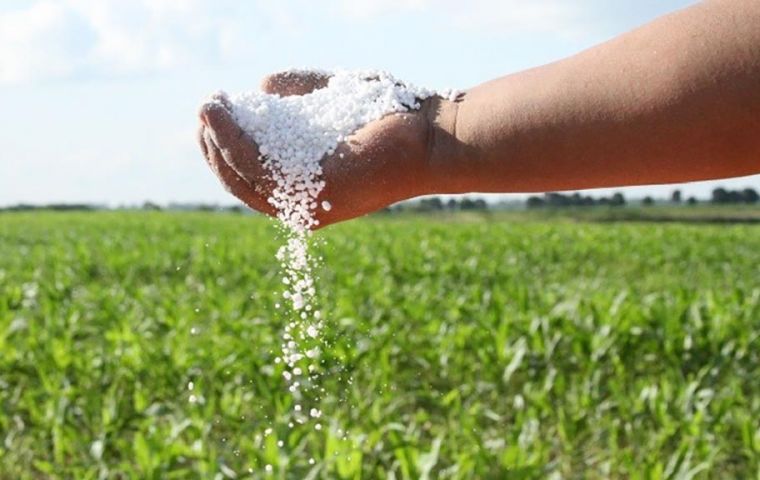MercoPress. South Atlantic News Agency
Brazil fertilizer consumption picking up as farmers replenish stocks and global prices drop 40%
 In 2022, after a 200% increase in fertilizer prices, deliveries to the Brazilian market fell by 10.4% compared to the previous year, totaling 41.078 million tons
In 2022, after a 200% increase in fertilizer prices, deliveries to the Brazilian market fell by 10.4% compared to the previous year, totaling 41.078 million tons Consultants and banks estimate that fertilizer consumption in Brazil will increase this year, with projections suggesting a range of 2.5% to 10% growth in deliveries. This increase is driven by producers’ need to replenish the volumes used in their crops as input prices have fallen.
In 2022, after a 200% increase in fertilizer prices, deliveries to the Brazilian market fell by 10.4% compared to the previous year, totaling 41.078 million tons, according to data from Brazil's National Association for Fertilizer Diffusion, ANDA.
For 2023, the market expects an increase in deliveries compared to 2022. The decline in fertilizer prices throughout the year, averaging 40% in imported input costs, and the fact that producers utilized part of the reserves accumulated in the soil in the previous year are contributing factors.
However, as of March, deliveries were 1.2% lower compared to the first quarter of the previous year, amounting to 8.553 million tons, according to Anda.
StoneX consultancy anticipates an increase of 2.5% to 5% in deliveries compared to 2022, reaching between 42 million and 43 million tons. Nevertheless, the numbers are subject to revision, according to Marcelo Mello, Director of Fertilizers at StoneX.
“The purchase of fertilizers by producers is significantly delayed, with a 16% decrease by the end of May compared to the previous two years. As we approach the second half, only 44% of the required amount has been sold, and the buying window is narrowing. This delay may ultimately impact the total deliveries for the year and create logistical challenges on the eve of the harvest,” explained Mello.
Itaú BBA expects a 7% increase in deliveries, totaling 43.592 million tons this year. Rabobank on the other hand estimates a 10% growth in volume delivered to the market, reaching 45.2 million tons.
The bank particularly predicts increased consumption of phosphate and potassium this year. Bruno Fonseca, Senior Agricultural Inputs Analyst at Rabobank, highlighted that while farmers still need to recover fertilizer purchases for the next planting season, consumption is expected to increase in 2023 and return to the trend line, as mentioned in a recent market report.
Meanwhile Brazilian oil giant, Petrobras, CEO announced he expects to resume work on a major nitrogen fertilizer project in the city of Tres Lagoas, and hinted at new gas projects in Bolivia.
CEO Jean Paul Prates anticipated starting construction again at the project at an event in Rio de Janeiro, though he did not provide a timeline, while also underlining that Petrobras is evaluating potential natural gas projects in neighboring Bolivia.
Tres Lagoas is located in the mid-western state of Mato Grosso do Sul, which borders Bolivia. Petrobras has tried for years to sell the Nitrogen Fertilizer Unit III (UFN-III) in Tres Lagoas. Construction was halted in 2014 with about 80% of the works completed.
When operational, the unit is expected to produce 2,200 tons of ammonia and 3,600 tons of urea daily, or about a fifth of the urea consumption in Brazil.
Prates did not link the fertilizer project with the possible investment in Bolivia, which already supplies volumes contracted by Brazil. But a new gas supply would help the fertilizer sector.
Prates said that the company will discuss with Bolivia financial terms, but did not provide further details.




Top Comments
Disclaimer & comment rulesCommenting for this story is now closed.
If you have a Facebook account, become a fan and comment on our Facebook Page!